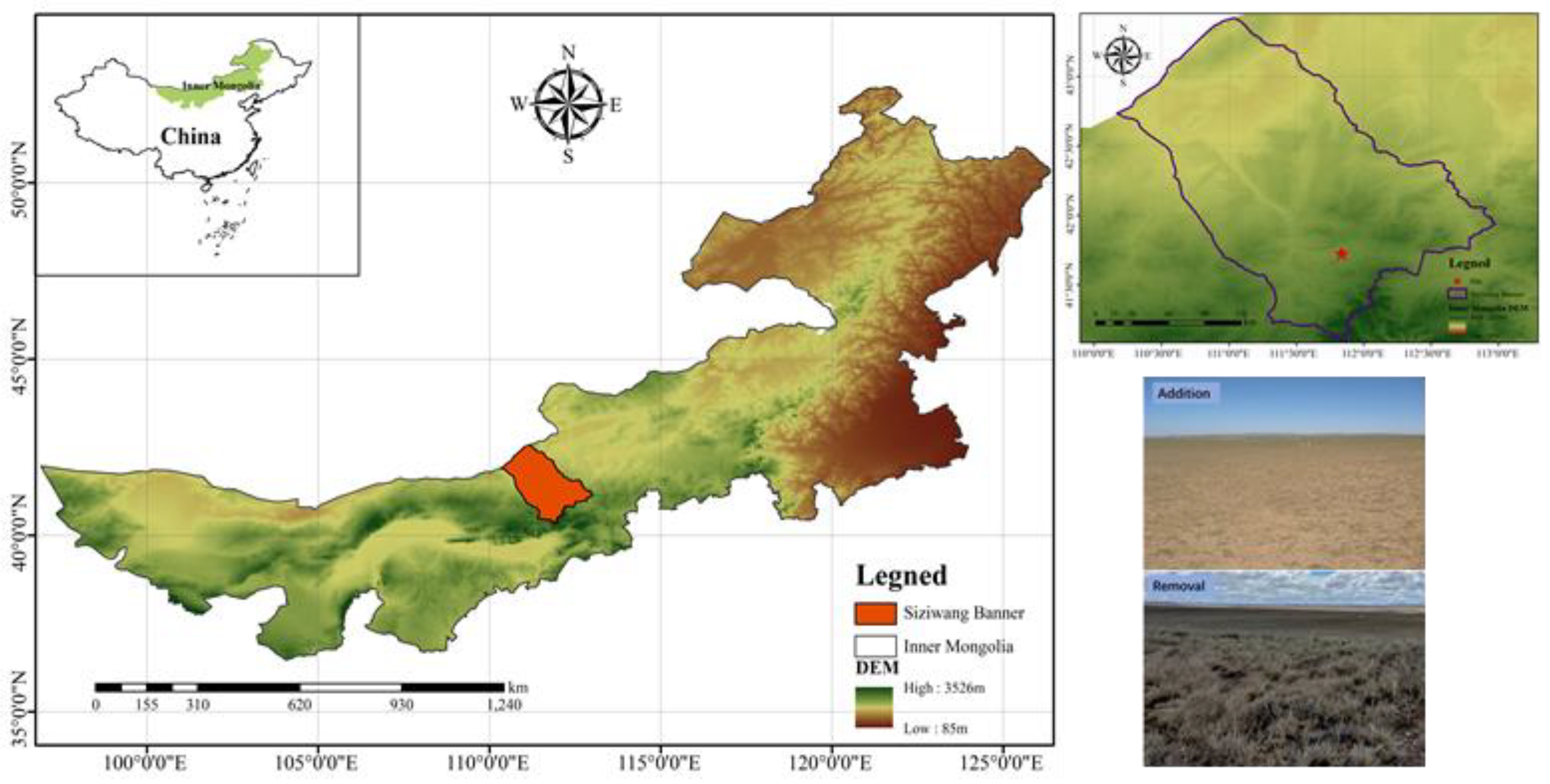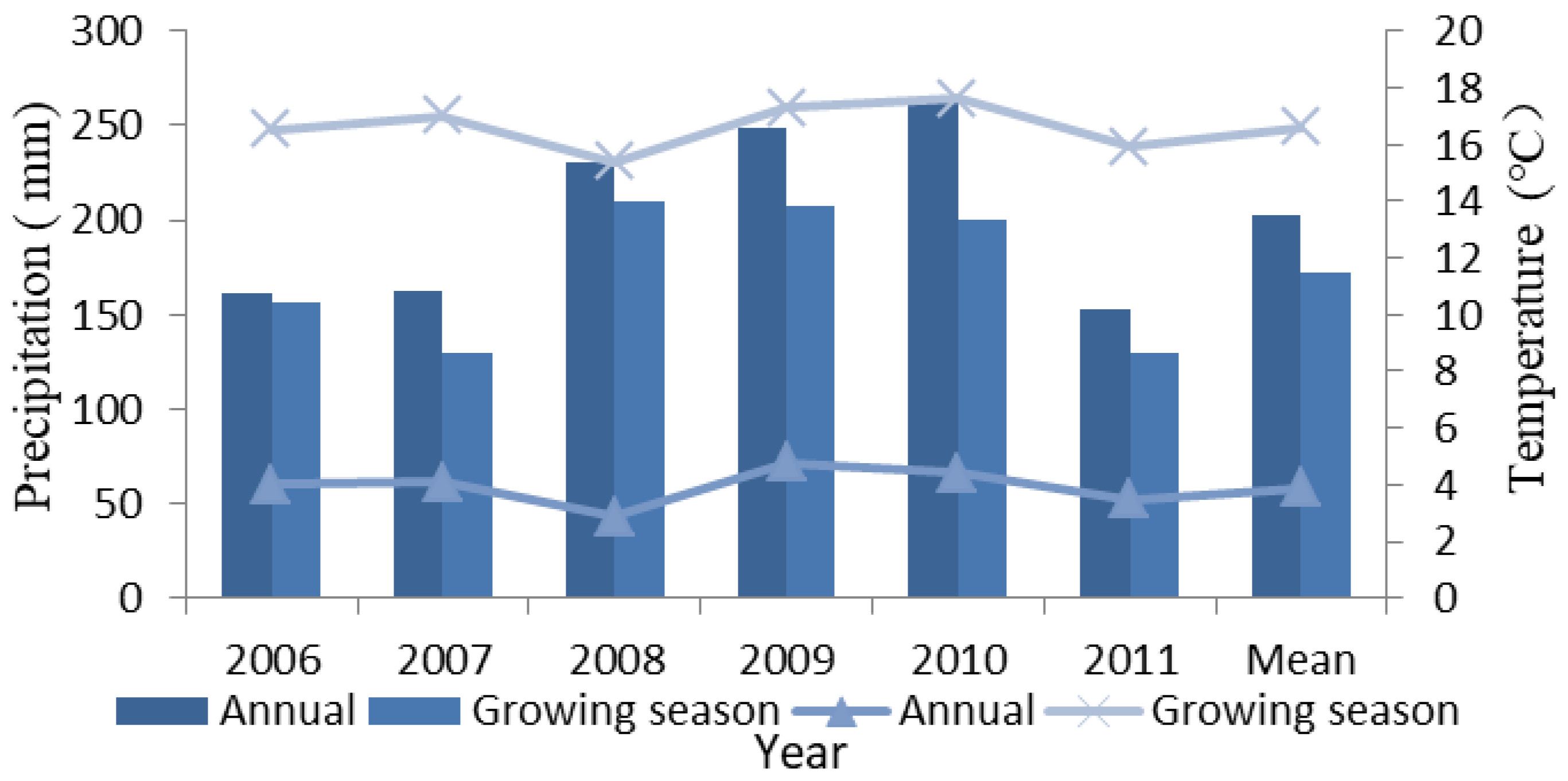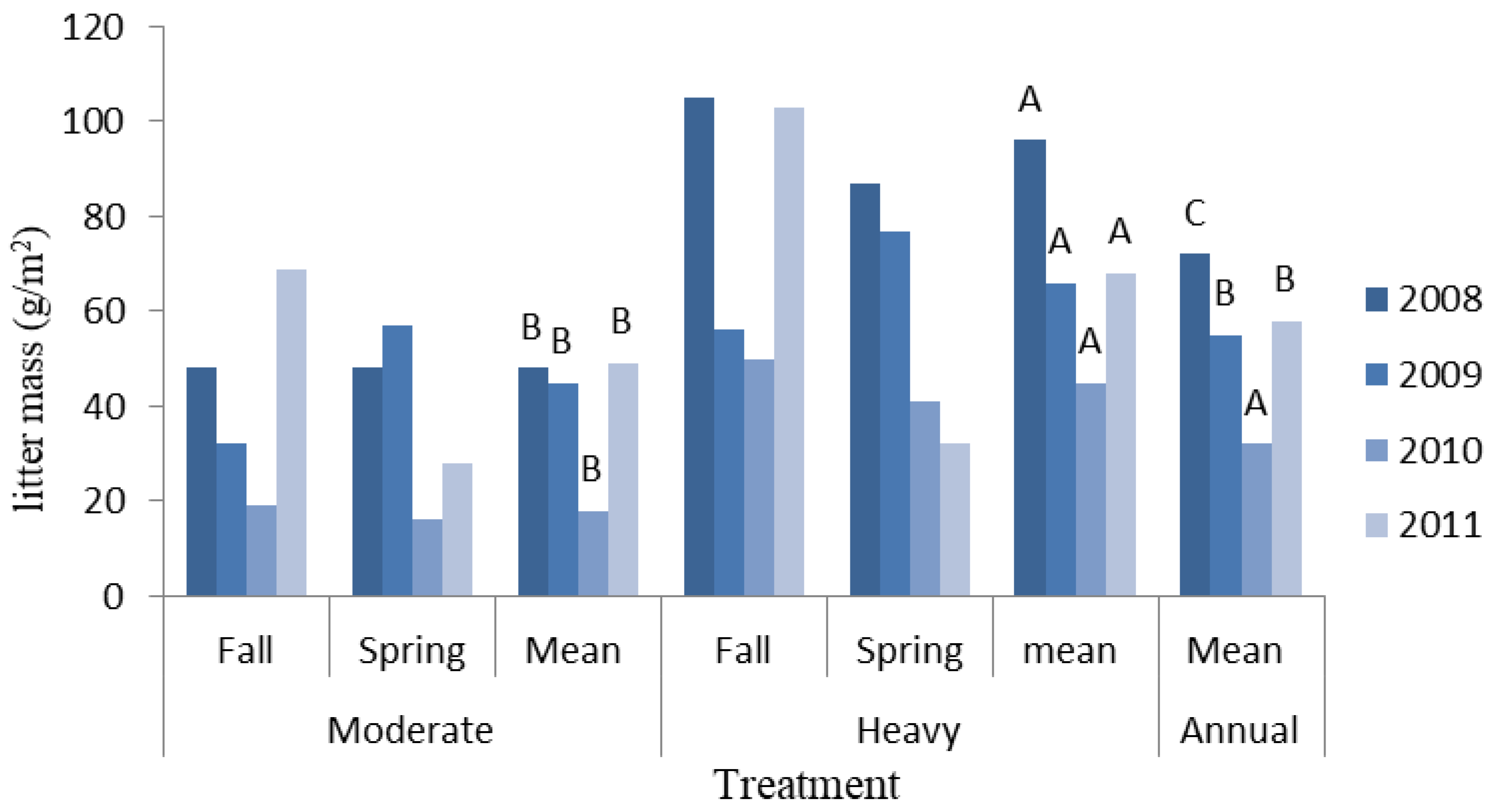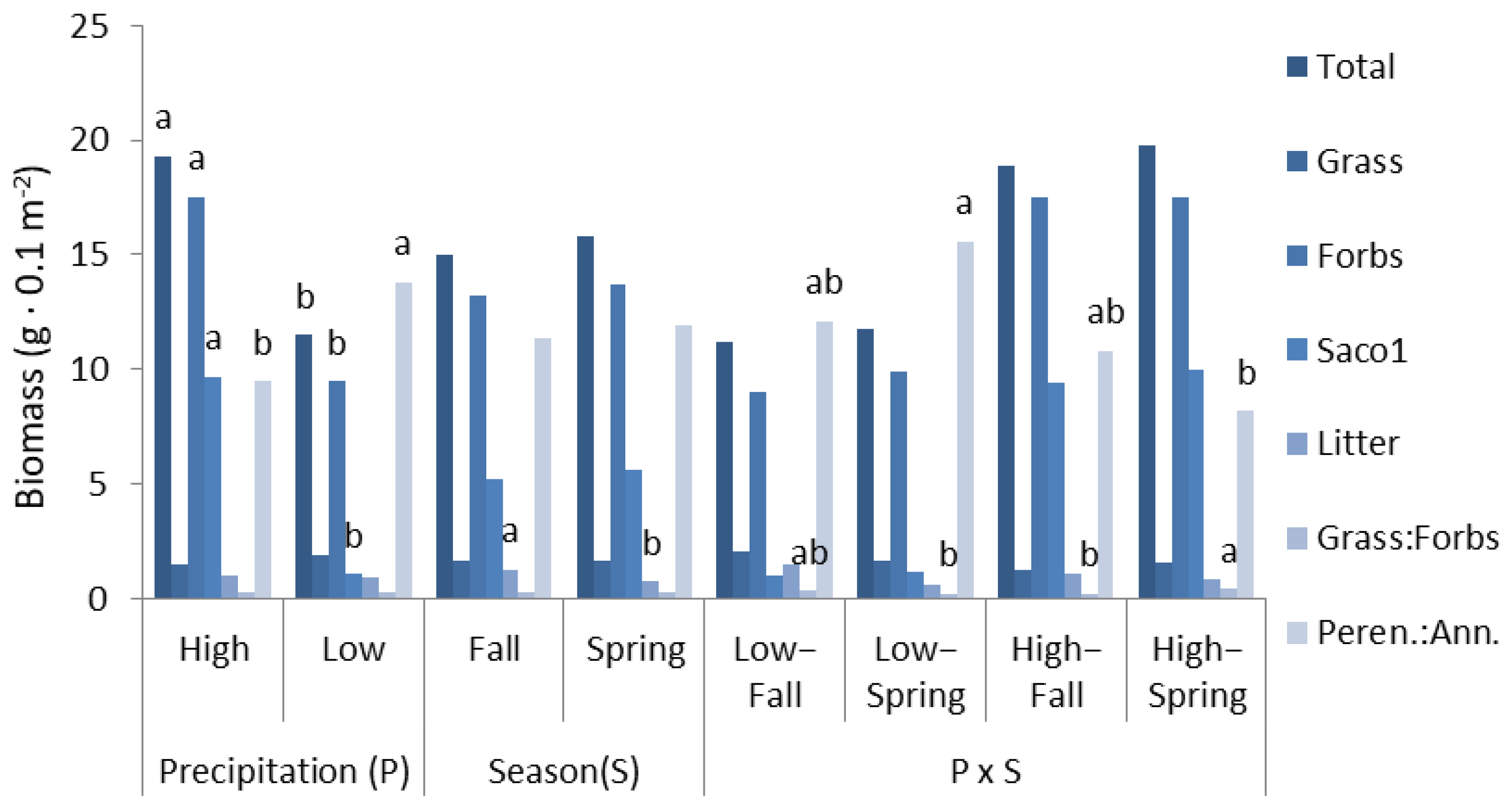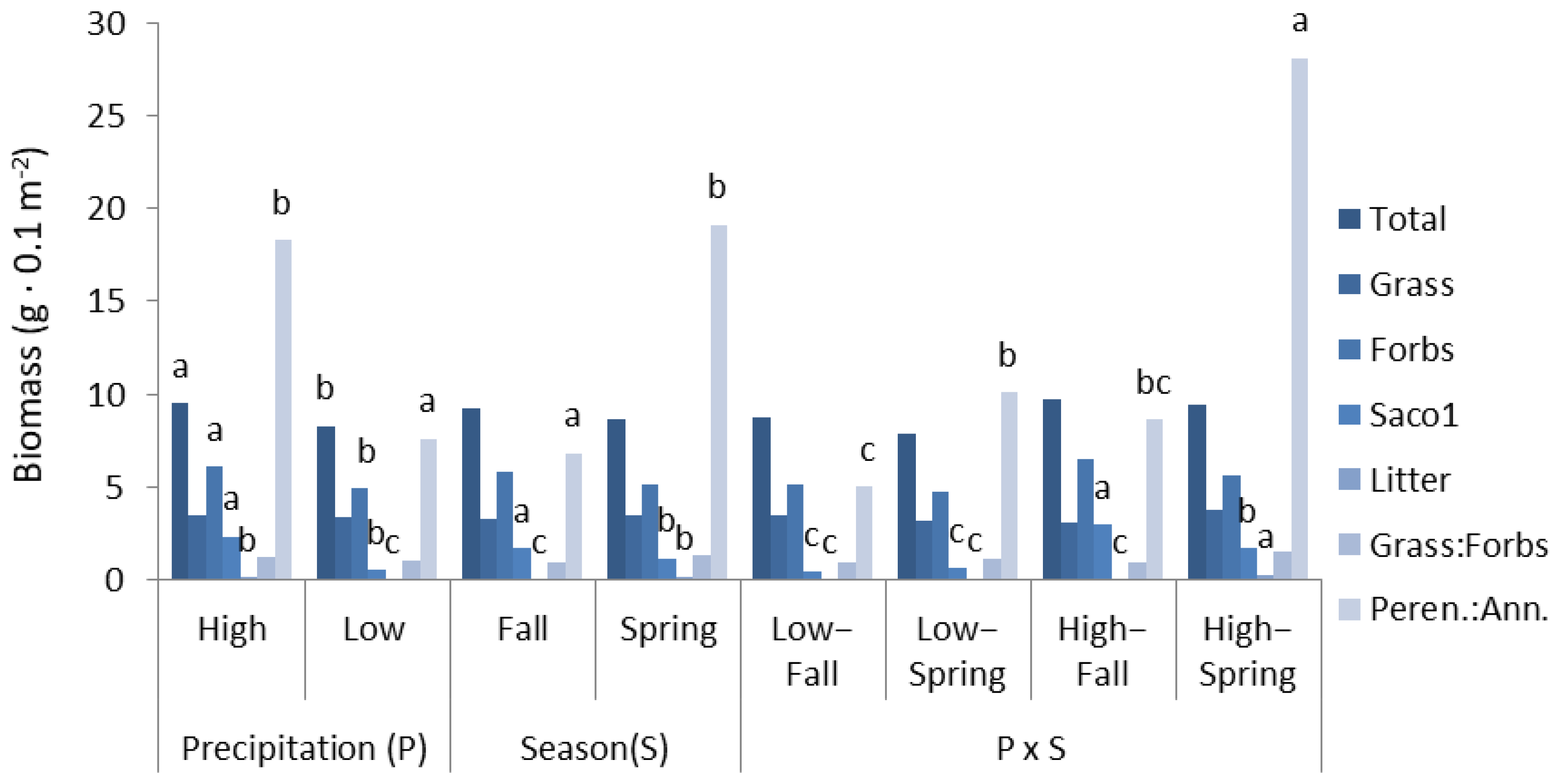1. Introduction
Litter is a component of terrestrial ecosystem and it plays an important role in plant productivity and abundance [
1,
2]. Most current research on litter focuses on its decomposition processes and effects on soil nutrients [
3,
4], as well as the relationship between soil microorganisms and litter addition or removal [
5,
6]. The dead herbage in grasslands has been referred to as a litter. It is herbage that has escaped herbivores and has senesced. As such, its palatability has severely deteriorated for most livestock, other mammals, and insects. Therefore, it is avoided by herbivores and will accumulate unless grazing pressure is increased and its loss is primarily dependent on physical weathering or microbia [
7] and photo-degradation [
8]. On the fescue grassland, biomass loss over the dormant season (from fall to spring) was 24, 43, and 56% on pastures that had been grazed light, moderate, and heavy for about 40 years [
9], which appeared to reflect the characteristics of vegetation that resulted from the long-term grazing treatment. Over a similar period, weight loss in leaves of Altai wildrye (
Leymus angustus [Trin.] Pilg.) was 41 and 52% in two different years [
10]. Nevertheless, livestock has the greatest effect on the amount of litter present on grazed grasslands. Changes in litter over time can also affect soil carbon cycling processes [
11].
While litter will intercept light rainfall [
12] which reduces the amount reaching the soil, it can significantly improve soil moisture status by capturing snow in winter [
13] and reducing losses from evaporation and surface runoff. Litter is an important ecosystem process, serving as a natural nutrient conduit and a major pathway to supplement available nutrients in plants [
14]. This may result in a 60% increase in aboveground net primary production (ANPP) on a Mixed Grass Prairie although the effect is linked to site and year [
15,
16], which dictates the extent that soil moisture limits production. Litter had a more significant role in regulating soil moisture in dry years and areas than in years and areas with adequate precipitation [
17]. Although water deficits are a feature of grasslands, in some years moisture may be sufficient so that it does not constrain ANPP while in years of extreme soil moisture deficits, there may not be sufficient water available for conservation to be effective [
16].
The effectiveness of litter for enhancing ANPP appeared to be considerably less on a Typical Steppe in Inner Mongolia [
18] that was dominated by
Stipa grandis P. A. Smirn and
Leymus chinensis (Trin.) Tzvel, than in the Mixedgrass Prairie [
16] or Parkland [
15]. Here, the primary effects of removing litter were to reduce soil moisture and grass biomass, in particular that of
L. chinensis, a rhizomatous species that is sensitive to soil moisture [
19]. While this trend is consequential for livestock management, total ANPP was not affected [
18].
The community response to litter is a function of its species’ composition and adaptation to their environment. Community composition and its productivity will be affected by litter treatment [
20]. The vegetation in the Desert Steppe of Inner Mongolia consists of drought-tolerant species that include bunchgrasses (
Stipa breviflora Griseb.,
Cleistogenes songorica (Roshev.) Ohwi), annual forbs (
Convolvulus ammannii Desr.,
Heteropappus altaicus (Willd.)
Novopokr.,
Neopallasia petinata (Pall.) Poljak.,
Kochia prostrata (L.)
Schrad.), and shrubs (
Caragana stenophylla Pojark.). When taken together with their tolerance to grazing, it suggests that the importance of litter may not be significant to their productivity. At present, the relevant studies on litters mainly focus on their accumulation, decomposition dynamics and microbiome [
3,
11,
21], and there are relatively few studies on the effects of litters on grassland, especially in desert steppe which is most sensitive to external interference.
Desert steppe is one of the main grassland types in the central and western Inner Mongolia Autonomous Region, accounting for 39% of the grassland area.
Stipa breviflora desert steppe occupies 11.2% of the total area of warm desert steppe [
22], which is an important type of desert steppe in Inner Mongolia and plays an important role in the economic development of animal husbandry and ecological services [
23]. Therefore, we conducted a study to examine the effect of removing or adding litter, during plant dormancy, in a single event on a plant community in the Desert Steppe, so as to more accurately understand the role of litters in the desert steppe ecosystem and provide data support for rational utilization of
Stipa breviflora grassland. Therefore, we conducted research to examine the effect of removing or adding litter, during plant dormancy, in a single event on a plant community in the Desert Steppe. We tested the hypothesis: (1) litter removal reduced ANPP while litter addition increased ANPP and (2) these effects were influenced by the season of treatment, whether fall or spring.
3. Results
The persistent effect of litter removal or addition over 3 years after treatment (growing years), or its interaction with precipitation, season of application or litter application treatment was not significant (p > 0.05). Therefore, we focus on the first year effect when the most dramatic changes might be expected.
Vegetation ground cover over the 5-yr study period on both the litter removal and litter addition sites was unaffected (
p > 0.05) by the litter treatment. Most covers were represented by forbs (23%) and a minor proportion by shrubs (<1%;
Table 1). Of the forbs,
Artemisia frigida and
Convolvulus ammannii accounted for a combined total of 14% ground cover while
Cleistogenes songorica and
Stipa breviflora accounted for a combined total of about 6% (
Table 1). Ground cover on the litter addition site was represented by similar species but total ground cover was less (23.9 vs. 29.7%), which reflected a diminished (about 50%) cover of both
Artemisia frigida and
Salsola collina.
Litter mass sampled in the first growing season after treatment represents the residual of the mass that was present after treatment and is the net mass after weathering losses. Litter mass in the removal experiment had accumulated as a result of its protection from grazing while litter in the addition experiment was nearly absent because of its history of heavy grazing immediately before the trial. In the removal experiment, the amount of litter present at the time of sampling after the first growing season did not reflect the treatments (
p > 0.05; 1.46, 1.39 and 1.06 g·0.1 m
2 in the control, moderate, and heavy removal treatments, respectively) where the mass of litter remaining after the first growing season was affected only by season (
Table 2 and
Table 3), with greater amounts present in the fall than in the spring treatment plots. In the litter addition experiment, the mass was greater (
p < 0.05) in spring than in fall and in years of high precipitation (
Table 4 and
Table 5). The level of litter addition was only affected by its interaction with precipitation (
Table 4). In years of low precipitation it was 0a, 0.2ab and 0.14bc g·0.1 m
2 in the control, moderate and heavy application treatments, respectively, while in years of high precipitation, the litter mass was 0.09ab, 0.27c, and 0.10ab g·0.1 m
2, respectively.
There was no significant effect on total ANPP and that of grass, forbs or
Salsola collina (
Table 2 and
Figure 4) in both removal and addition treatments, in the first year after treatment. The effects of precipitation in the growing season (defined by classification values as a high (
= 203 mm) or low (
= 130 mm) annual total) in the removal and addition treatments were most significant and the consistent effects on the variables measured were similar. In the litter removal experiment, total ANPP in high precipitation years was about 40% greater than in low precipitation years, with most contributed by a greater yield of
Salsola collina (
Figure 4). In the litter addition treatments, the differences were smaller but also contributed mostly by the response of
Salsola collina (
Figure 5).
The effect of the season that litter was removed was mostly to modify (
p < 0.05) the effects of precipitation on the ratio of grass:forbs and perennial:annual species (
Table 2) while the season of litter addition modified (
p < 0.05) the effects of precipitation on the ANPP of
Salsola collina and the ratio of perennial:annual plants (
Table 3). The ratio of grass:forbs was greater (
p < 0.05) with litter removal in spring than in fall when precipitation was high, but similar (
p > 0.05) between seasons when precipitation was low (
Table 2). The ratio of perennial:annual species with litter removal was similar (
p > 0.05) between seasons within a precipitation category but it was greater (
p < 0.05) in spring when precipitation was low than when it was high (
Table 2 and
Figure 4).
The season of litter addition had no effect (
p > 0.05) on the ANPP of
Salsola collina when precipitation was low but in years of high precipitation the effect was greater (
p > 0.05) with addition in fall rather than spring (
Table 3 and
Figure 5). Within a precipitation category, litter addition in spring resulted in a higher ratio of perennial:annual plants than in fall (
Figure 4).
In both the litter removal and addition experiments, the ground cover of most species selected for examination was not affected (
p > 0.05) by litter treatment but primarily by precipitation (
Table 4 and
Table 6). Nevertheless, in the removal experiment, the ground cover of
Stipa breviflora was affected (
p < 0.05) by the interaction of litter removal intensity and season of treatment (
Table 4 and
Table 5). In fall, the percent ground cover of
Stipa breviflora was 1.6a, 1.6a and 2.8b% (means with different superscript letters are different,
p < 0.05) in the control, moderate and heavy removal treatments, respectively, and in spring the ground cover was 2.6b, 2.4b, and 1.8b%, respectively, for the same removal treatments. The ground cover of
Neopallasia pectinata was affected (
p < 0.05) by the interaction of litter removal and precipitation. In years of low precipitation its percent ground cover was 2.0b, 3.3c, and 3.4c% in the control, moderate and heavy removal treatments, respectively, while in years of high precipitation the cover was, 0.4a, 0.2a, and 0.4a%, respectively, for the same removal treatments.
In the litter addition experiment, the ground cover of
Neopallasia pectinata was affected (
p < 0.05) with litter addition (1.1a, 2.1b and 1.5ab%; means with different superscript letters are different, in the control, moderate and heavy addition treatments, respectively). The cover of
Neopallasia pectinata and
Salsola collina was greater (
p < 0.05) when litter was added in the fall than in the spring (
Table 6 and
Table 7). Also, litter addition reduced (
p < 0.05) the cover of
Convolvulus ammannii although this effect was only evident in years of low precipitation when the cover was 4.9b, 2.8a and 2.7a% in the control, moderate and heavy addition treatments, respectively, compared with 2.2a, 2.1a and 1.9a% in the same treatments, respectively.
Precipitation had an inconsistent effect on plant height in both litter removal and addition experiments (
Table 8 and
Table 9). In the litter removal experiment years of high precipitation resulted in taller plants of
Stipa breviflora and
Salsola collina but
Cleistogenes songorica and
Neopallasia pectinata were shorter (
p < 0.05;
Table 10) while in the litter addition experiment both grasses were taller but the affected forbs were shorter (
p < 0.05;
Table 11). Fall litter removal resulted in taller plants of
Cleistogenes songorica (
p < 0.05) but its effect was modified by precipitation (
Table 8 and
Table 10). The height of
Salsola collina was also affected by season and precipitation (
Table 8) while the height of
Stipa breviflora was influenced by the interaction of litter removal and precipitation. Here, the height of
Stipa breviflora was greatest with heavy removal in years of low precipitation (4.5a, 4.6a and 6.5b cm, respectively, in the Control, Moderate and Heavy removal treatments; means having different letters are different,
p < 0.05) but similar (
p > 0.05) among treatments in years of high precipitation (8.0, 7.3 and 7.2 cm, respectively).
The significant (p < 0.05) 3-way interaction of precipitation, season and litter addition for Stipa breviflora appeared to be caused primarily by taller plants (p < 0.05) produced with high precipitation and heavy litter addition in fall (7.2 cm) than in spring (5.6 cm) for the same conditions. For Artemisia frigida the effect appeared to be produced by taller plants when precipitation was high and with heavy litter addition in spring (4.5 cm) compared with low precipitation and heavy litter addition in spring (5.9 cm).
Indicator species analyses of litter removal (based on species mass) showed that only Krascheninnikovia ceratoides provided an indication of treatment effect [Indicator value (IV) = 15.5; p = 0.04]. Its relative abundance was 13%, 22% and 65% for the control, moderate and heavy litter removal treatments, respectively. A further examination of this species using analysis of variance also indicated a significant (p = 0.01) response to litter removal (0.3%, 0.2%, and 1.2%, for the same treatments, respectively) with a suggestion that its cover was influenced by precipitation (p = 0.07) where it exhibited similar ranking among treatments in both years but was greater (p = 0.02) in dry years ( = 1.0% and 0.1%, in dry and wet years, respectively). Species that distinguished between low and high precipitation years were: Cleistogenes songorica (IV = 55.4, p = 0.01), Convolvulus ammannii (IV = 60.7; p ≤ 0.01), Salsola collina (IV = 62.7; p < 0.01), Neopallasia pectinata (IV = 59.5; p ≤ 0.01), Bassia prostrata (IV = 33.1; p < 0.01) and Agropyron cristatum (IV = 13.6; p = 0.01). Their relative abundance, in the low and high precipitation years were, respectively for each species: 61 and 39, 36 and 64, 11 and 89, 90 and 10, 64 and 36, and 0 and 100.
In the litter addition experiment, there were no species that provided significant (p < 0.05) indication of litter addition. Species that were an indicator for low and high precipitation years were: Salsola collina (IV = 74.8; p < 0.01), Neopallasia pectinata (IV = 44.3; p ≤ 0.01), Allium tenuissimum (IV = 15.9; p = 0.05), Agropyron cristatum (IV = 12.2; p = 0.05), Leymus chinensis (20.9; p = 0.02); and Artemisia commutata Bess. (IV = 32.5; p < 0.01). Their relative abundances in years of low and high precipitation were, respectively, 13 and 87, 71 and 29, 65 and 35, 0 and 100, 74 and 26, and 91 and 9.
4. Discussion
The effects of a single time of litter removal or addition on the short-term effects on vegetation expressed by ANPP, ground cover and plant height were examined. Litter removal or addition were both expected to affect the microclimate of the soil [
26], which were evaluated by measuring the plant response. While both experiments would have impacted the soil microclimate, the response of the plant community could be expected to differ because in one case litter was removed from a community that had been protected from grazing for 11 years while in the second experiment, litter was added to a grazed site. Nevertheless, the same major species were present at both sites and in similar composition as estimated by canopy cover. Therefore, the primary distinction between them was the mass of litter and their total ground cover.
As in all arid regions, the principal driver of production and species dynamics in the Desert Steppe is precipitation, which in itself is hardly noteworthy, while the effect of the season that litter was applied is obscured by the fact that it included treatments ranging from a control to heavy litter removal or addition. It has been shown that increasing precipitation under the treatment of added litter significantly increased grassland biomass [
27], and the same conclusion was obtained in semi-arid grasslands, where the increase in litter and precipitation significantly increased community composition [
28]. Therefore, it is the interactions of precipitation or season with litter application treatments that are the most revealing. We anticipated that the effect that season had on litter treatments would be expressed through litter mass, whether left in situ or added, on snow capture over winter [
13], or by its influence on the loss of soil moisture in either winter or spring. The effect of season was most demonstrable with
Salsola collina where only litter addition in fall increased its mass and cover, and only in years of high precipitation. Nevertheless, this does not explain the lack of a significant interaction of season with the litter treatment.
The presence of litter in grassland serves to moderate the soil environment and its removal exposes it to greater extremes of temperature, evaporation and, therefore, soil moisture [
16]. And soil moisture is the main factor affecting the community structure of desert grassland [
29]. Consequently, the community response to litter mass is emulated by the precipitation regime, which can provide some clues to how the community might respond to a more favorable moisture regime. Nevertheless, the opportunity for litter to modify the soil environment is dependent on its mass and the occurrence of soil moisture. In the present study, the mass of litter present was very small (14.6 g·m
−2) compared with the Typical Steppe in Inner Mongolia (140 g·m
−2 [
18]) or the Mixed Prairie in Canada (1171 g·m
−2 [
15]). Willms et al. (1993) found that litter had no effect on ANPP in a year with above-average precipitation and had a decreased effect in a year with under-average precipitation; while in both studies by Willms et al. (1993) and Wang et al. (2011) after litter removal, soil heat units were the greatest.
Therefore, there are several factors that may have mitigated the treatment differences in the present study. Perhaps the more likely factor is that the effect of a small litter mass is below a threshold effect that can be detected. In the study by Willms et al. (1993), the year with the least amount of rainfall had 227 mm which was marginally greater than the average of 203 mm in the present study. In the previous study, the coefficient describing the relationship of litter mass to ANPP was 0.114. When applied to the average litter in the control of the present study (14.6 g·m−2), the effect on yields would be about 2 g·m−2. Another factor that would mitigate the effect of litter is that water conservation is irrelevant because a majority of annual precipitation (85%) occurs in the growing season (May to September) when the rainfall would be quickly used by plants.
Our inability to detect differences in litter mass between removal or addition treatments after the first growing season is not only an indication of the high variability among plots and the relatively reduced effectiveness of litter in the Desert Steppe but is also exacerbated by a high rate of litter decomposition that would further reduce treatment differences. While an average of 69 g·m
−2 were removed from the high removal treatment, which is an estimate of the total amount of litter in that site, only about 15 g·m
−2 were sampled in the control plots the next summer, which suggests a loss of about 78%, presumably the result of weathering and herbivory. The dry matter losses on the addition site were considerably greater, amounting to virtually all measurable litter. Willms et al. (1996) reported average losses of 24%, 43%, and 56% from fall to spring from ungrazed, moderately grazed, and heavily grazed fescue grassland, community, respectively, suggesting that losses were determined by the species contributing to the biomass [
9]. In the Desert Steppe, a large proportion of biomass consists of annual plants, which are highly susceptible to weathering and fragmentation. This would be particularly pronounced where litter had been added because it had already been detached and disturbed by raking and application.
The loss of litter after treatment means that any apparent effectiveness will also degrade over time, and its effect on production will depend on the amount of moisture in the soil when the temperature becomes favorable for growth in spring [
30]. The presence of litter can affect snow capture as well as water conservation in spring and summer. However, on average, over 80% of precipitation occurred during the growing season from May to September and very little as snow, which would diminish this potential.
The short-term relationship between litter quantity and yield is related to its water retention capacity, while evidence [
7] shows that species composition may also be affected. where litter is removed over a longer period of time. Few effects of litter during the first growing season after treatment, and no lasting effect after that, thereafter, indicated a high degree of resilience of plant communities and dominant individual species. Repeated treatment of litter may produce detectable changes in species composition by allowing plants to adapt to new soil moisture, but this possibility is hypothetical. A grazing study in desert steppes suggested that this could happen, but it hypothesized that grazing and litter removal would have a similar effect in arid environments. Li et al. (2008) reported no effects of grazing or litter mass on the dominant species or ANPP in a Desert Steppe after 4 to 6 years of treatment even though litter mass declined from 66 to 16 g·m
2 with heavy grazing intensity from an ungrazed control [
31]. An examination of the canopy cover of individual species confirms their relative stability in relation to litter mass with only a few exceptions that include both perennial and annual species in both litter removal and addition treatments.
Measures of the canopy cover of individual species is a more rapid estimate of abundance than ANPP and subject to fewer potential errors during the harvesting to weighing stages because it is measured in situ. Therefore it provides useful information on the individual species’ response to disturbances, which litter removal and addition represent. We observed very few examples of species responding to these treatments but they indicate that the annual forb,
Neopallasia pectinata, tended to favor greater masses of litter while perennial species favored less litter. The effect of the proportion of different species in the litter is not excluded [
4]. Litter may provide
Neopallasia pectinata a more favorable environment for seed germination in years of low precipitation, which was facilitated with litter addition in one experiment. The litter addition experiment included the potential process of introducing seed with the litter, which may have increased the cover of
Neopallasia pectinata. However, this was not observed with
Salsola collina, a more abundant annual forb, which exhibited an insignificant increase of 0.5% with litter addition. As succession progresses, litter accumulation can alter seed dispersal patterns, which may have implications for the long-term dynamics of plant populations [
32].
The smaller canopy cover of the perennial species, Stipa breviflora, Convolvulus ammannii and Krascheninnikovia ceratoides to reduced litter mass may indicate sensitivity to shading, although that explanation was not tested. It seems supported by the observation that the canopy cover of Stipa breviflora increased only with fall litter removal, when the presence of litter would have a greater impact over a longer period, and litter addition reduced the cover of Convolvulus ammannii only in years of low precipitation when the plant was subject to additional stress. Similarly, the greater plant height of Stipa breviflora to heavy litter removal in dry years may have been in response to the same processes, although the explanation of its height response to litter addition is obscured by the complexity of a 3-way interaction.
The greatest proportion of plant types found in this community is annual forbs, consisting primarily of
Salsola collina and
Neopallasia pectinata, which demonstrate the greatest fluctuation in relation to precipitation and, to a considerably smaller degree, the litter treatments. The presence of litter changes soil available water [
33]. On the other hand, the ANPP of grass expressed stable production regardless of precipitation, reflecting a highly drought-resistant trait, and only the cover of individual species responded to precipitation. The effect of the changes resulted in a greater proportion of perennial to annual species with low precipitation in the litter removal experiment but a lower proportion in the addition experiment. The differences in trends between the two experiments appeared to be dictated by the relative mass of grass and forbs and the contrasting response of
Salsola collina and
Neopallasia pectinata to moisture regimes, where
Salsola collina increased and
Neopallasia pectinata decreased with greater precipitation.
